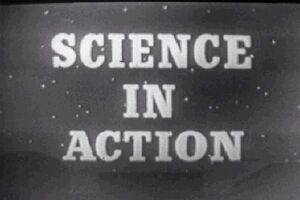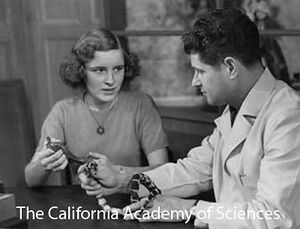Difference between revisions of "Series:Science in Action"
| Line 10: | Line 10: | ||
* 1956 [[Moving Image:Science in Action - Aero Medicine]] | * 1956 [[Moving Image:Science in Action - Aero Medicine]] | ||
* 1956 [[Moving Image:Science in Action - Rivers of Ice]] | * 1956 [[Moving Image:Science in Action - Rivers of Ice]] | ||
* 1956 [[Moving Image:Science in Action - Submarines]] | |||
* Science in Action #35 - PLANTS AND FAIRYLAND | * Science in Action #35 - PLANTS AND FAIRYLAND | ||
* Science in Action, Nov. 28, 1955 - Earth's Backbone | * Science in Action, Nov. 28, 1955 - Earth's Backbone | ||
Revision as of 13:13, 21 December 2021
Science in Action is a series that ran from 1952 to 1966, produced by the California Academy of Sciences in Golden Gate Park, San Francisco.
The series began in 1950 as a popular 15-minute segment on a popular Bay Area television program, The Del Courtney Show. Tom Groody discussed scientific topics and animals. Eventually, Groody’s Science in Action segment became a regular 13-week feature on the program, presenting contemporary science issues.
Installments
- 1956 Science in Action - Radar Defense Screen
- 1956 Science in Action: Drilling for Oil
- 1956 Science in Action - Aero Medicine
- 1956 Science in Action - Rivers of Ice
- 1956 Science in Action - Submarines
- Science in Action #35 - PLANTS AND FAIRYLAND
- Science in Action, Nov. 28, 1955 - Earth's Backbone
- Episode 379 The Chair
- Episode 146: "The Flow of Heat" first aired on March 23, 1954.
- Transistors. Written by Draper, Benjamin.
- Science of Baking
- Episode 569: “Bird Island” aired February 7, 1960.
Description, via California Academy of Sciences
In the spring of 1950, “Science in Action” began as a fifteen minute segment on a popular Bay Area television program called “The Del Courtney Show.” Academy staffer Tom Groody made a guest appearance on the program during which time he discussed scientific topics and brought in animals from the Academy’s Steinhart Aquarium. The segment was wildly popular and Groody was invited to return and further discuss contemporary science issues. Eventually, Groody’s Science in Action segment became a regular thirteen week feature in the program.
Shortly thereafter, a half-hour weekly evening television series was developed to discuss timely and significant scientific subjects with guest scientists, demonstrations, and an animal of the week exhibition. By fall of 1950, the “Science in Action” television show was the first live science program on television in the country and forged the path for science programs as we know them today.
In 1952, California Academy of Sciences superintendent Dr. Earl S. Herald took over the role as host of Science in Action. Herald’s spontaneity and charm quickly put guests at ease and made the topics easily understandable for the audience at large. The program raised public awareness and increased traffic to the Aquarium, especially the animal of the week exhibition, which featured wild animals on live television. In one reported incident, newly born water snakes had escaped from the set of Science in Action into the television studio during a live broadcast. Because of this publicity, over five thousand people stopped in to the Aquarium the following week asking to see the baby snakes. Additionally, it was not uncommon to see a handler get bit or an animal defecate and without missing a beat, Herald would offer the clever banter that endeared him to home audiences. In June of 1966, due to rising costs of production, Dr. Herald hosted the 626th and final episode of “Science in Action”.

